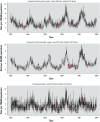Extreme Precipitation and Emergency Room Visits for Gastrointestinal Illness in Areas with and without Combined Sewer Systems: An Analysis of Massachusetts Data, 2003-2007
- PMID: 25855939
- PMCID: PMC4559956
- DOI: 10.1289/ehp.1408971
Extreme Precipitation and Emergency Room Visits for Gastrointestinal Illness in Areas with and without Combined Sewer Systems: An Analysis of Massachusetts Data, 2003-2007
Abstract
Background: Combined sewer overflows (CSOs) occur in combined sewer systems when sewage and stormwater runoff are released into water bodies, potentially contaminating water sources. CSOs are often caused by heavy precipitation and are expected to increase with increasing extreme precipitation associated with climate change.
Objectives: The aim of this study was to assess whether the association between heavy rainfall and rate of emergency room (ER) visits for gastrointestinal (GI) illness differed in the presence of CSOs.
Methods: For the study period 2003-2007, time series of daily rate of ER visits for GI illness and meteorological data were organized for three exposure regions: a) CSOs impacting drinking water sources, b) CSOs impacting recreational waters, c) no CSOs. A distributed lag Poisson regression assessed cumulative effects for an 8-day lag period following heavy (≥ 90th and ≥ 95th percentile) and extreme (≥ 99th percentile) precipitation events, controlling for temperature and long-term time trends.
Results: The association between extreme rainfall and rate of ER visits for GI illness differed among regions. Only the region with drinking water exposed to CSOs demonstrated a significant increased cumulative risk for rate (CRR) of ER visits for GI for all ages in the 8-day period following extreme rainfall: CRR: 1.13 (95% CI: 1.00, 1.28) compared with no rainfall.
Conclusions: The rate of ER visits for GI illness was associated with extreme precipitation in the area with CSO discharges to a drinking water source. Our findings suggest an increased risk for GI illness among consumers whose drinking water source may be impacted by CSOs after extreme precipitation.
Citation: Jagai JS, Li Q, Wang S, Messier KP, Wade TJ, Hilborn ED. 2015. Extreme precipitation and emergency room visits for gastrointestinal illness in areas with and without combined sewer systems: an analysis of Massachusetts data, 2003-2007. Environ Health Perspect 123:873-879; http://dx.doi.org/10.1289/ehp.1408971.
Conflict of interest statement
The authors declare they have no actual or potential competing financial interests.
Figures


References
-
- Checkley W, Epstein LD, Gilman RH, Figueroa D, Cama RI, Patz JA, et al. Effect of El Niño and ambient temperature on hospital admissions for diarrhoeal diseases in Peruvian children. Lancet. 2000;355:442–450. - PubMed
MeSH terms
Substances
LinkOut - more resources
Full Text Sources
Other Literature Sources

